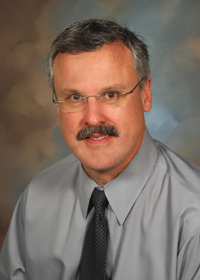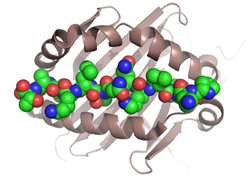Peter E. Jensen
Professor and Chair of Pathology
Chairman of the Board of Directors, ARUP Laboratories
Antigen Presentation

Molecular Biology Program
Education
B.S. University of Georgia
M.D. Vanderbilt University
Research
Our laboratory is focused on antigen processing and presentation, and the role of classical and nonclassical histocompatibility (MHC) molecules in regulating immune responses. A major interest is directed towards investigating the MHC class II antigen presentation pathway, which is required for antigen recognition by CD4+ T lymphocytes. Peptide binding by class II histocompatibility proteins is a critical event in shaping the T cell repertoire and the generation of both adaptive immunity and immunological tolerance. The class II peptide-loading pathway is highly regulated. HLA-DM plays a key role in the MHC class II presentation pathway: catalyzing peptide loading, editing the repertoire of peptides displayed to CD4+ T cells, and acting as a chaperone for empty class II molecules. However, the biochemical mechanisms underlying these functions are poorly understood. Biochemical experiments are being done to further investigate the structural basis for DM function and to test the hypothesis that DM is subject to allosteric regulation. We are also investigating the function of HLA-DO is a highly conserved negative regulator of DM function whose biological role remains quite mysterious. Another poorly understood component of the class II antigen presentation pathway relates to the mechanisms responsible for unfolding and fragmenting protein antigens in the endosomal compartments of antigen presenting cells. We are particularly interesting in identifying novel enzymes and transporters that may be involved in disulfide reduction and protein unfolding.
Our lab is also studying the function of so-called “non-classical” class I MHC (class Ib) molecules in the immune system. A major focus in this area is on the structure and function of murine Qa-1 and its human counterpart, HLA-E. These molecules can present antigen to a subset of unconventional CD8+ T cells that may have specialized regulatory function. A T cell receptor (TCR) transgenic mouse model was developed to investigate thymic selection and the in vivo function of T cells with this specificity. Qa-1 and HLA-E have nearly identical peptide binding specificity and they prefer to bind a group of closely related peptides derived from the leader peptides of classical class I molecules. These molecules regulate innate and adaptive immune response by interacting with CD94/NKG2 receptors on NK cells, NK-T, and CD8+ T cells, as well as through antigen presentation to CD8+ T cells. Site-specific mutagenesis and other approaches are underway to investigate the structural basis of the function of Qa-1 and HLA-E. In addition, we have developed a mouse model in which all existing T cells have specificity for nonclassical MHC molecules. These mice have a surprising ability to mount protective immune responses to bacterial and viral pathogens, and we are investigating the underlying mechanisms to reveal previously unappreciated pathways available to provide host defense and regulation of the adaptive immune system.

References
- LI Q, Shakya A, Guo X, Zhang H, Tantin D, Jensen PE, Chen X (2012). Constitutive nuclear localization of NAT in Foxp3+ regulatory T cells independent of calcineurin activity. J Immunol, 188, 4268-4277.
- Chen L, Jay Dc, Fairbanks JD, He X, Jensen PE (2011). An MHC class 1b-restricted CD8+T cell response to lymphocytic choriomeningitis virus. J Immunol, 187, 6463-6472.
- Escobar H, Reyes-Vargas E, Jensen PE, Delgado JC, Crockett, DK (2011). Utility of characteristic QTOF MS/MS fragmentation for MHC class I peptides. J Proteome Res, 10, 2494-2507.
- Zhou Z, Callaway KA, Weber DA, Jensen PE (2009). Cutting edge: HLA-DM functions through a mechanism that does not require specific conserved hydrogen bonds in class II MHC-peptide complexes. J Immunol, 183, 4187-4191.
- Chen LC, Delgado JC, Jensen PE, Chen X (2009). Direct expansion of human allospecific Fox P3+CD4+ regulatory T cells with allogeneic B cells for therapeutic application. J Immunol, 183, 4094-4102.
- Delgado JC, Escobar H, Crockett DK, Reyes-Vargas E, Jensen PE (2009). Identification of naturally processed ligands in the C57BL/6 mouse using large-scale mass spectrometric peptide sequencing and bioinformatics predication. Immunogenetics, 61, 241-246.
- Delgado JC, Jensen PE (2008). Cat and mouse. Nat Immunol, 9, 829-830.
- Chen X, Jensen PE (2008). MHC clsss IIantigen presentation and immunological abnormalities due to deficiency of MHC class II and its associated genes. Exp Mol Pathol, 85, 40-44.
- Chen X, Jensen PE (2008). The role of B lymphocytes as antigen-presenting cells. Arch Immunol Ther Exp (Warsz), 56, 77-83.
